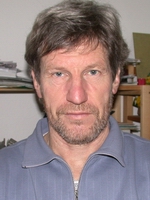
 |
Prof. Dr. Reinhold Hustert, |
| Curriculum vitae |
My interest in sensory-motor systems and motor control arose from a dedication to sports and biology developed some years after I was born in November 1943 in Haag, Bavaria. During my school career at the Albertus-Magnus-Gymnasium in Cologne I favoured team handball and building model planes and sailboats. I made it to study physical education and biology in 1964 at the Deutsche Sporthochschule and at the University of Cologne. My diploma thesis for physical education on cybernetic aspects of physical exercise in 1966 (supervisor: Prof. W. Hollmann) made me aware of how little is known about the details of neural control in movements of humans and animals. So my further biology interests focussed more on animal physiology. After graduation for highschool teaching in biology (1969) and physical education (1968) the experience of part time school teaching at the Montessori-Gymnasium of Cologne (1968-1972) decreased my initial enthusiasm for teaching school topics with annual repetitions. Instead, the insect neurobiology work done in the laboratory of Prof. Franz Huber caught my interest. There, my doctoral thesis work on the neural control of insect ventilation in 1970 began in its a first year with mainly micro-dissecting the locust abdomen. This new world opened my eyes to how many new sensory organs exist and I wondered how they contribute to behaviour. Since then insect sensory-motor systems are my favourite research subject. Two post-doctoral years 1974/75 in Seattle (hosted by J. S. Edwards) yielded additional insight into developmental aspects of the insect CNS. In my following years 1976 to 1988 at the University of Konstanz in the group of Prof. Ernst Florey I could cooperate with several excellent collaborators and we identified many new insect mechanoreceptors, their selective projections in the CNS, and some of their functions in reflexes and behaviour. Appointed since 1988 at the Zoology Institute of the University of Göttingen, projects on contact chemoreceptors, insect ventilation and circulation, and more recently the descending brain control of locusts by their visual system continued to keep me and my small group busy. |